Page 284 of 350
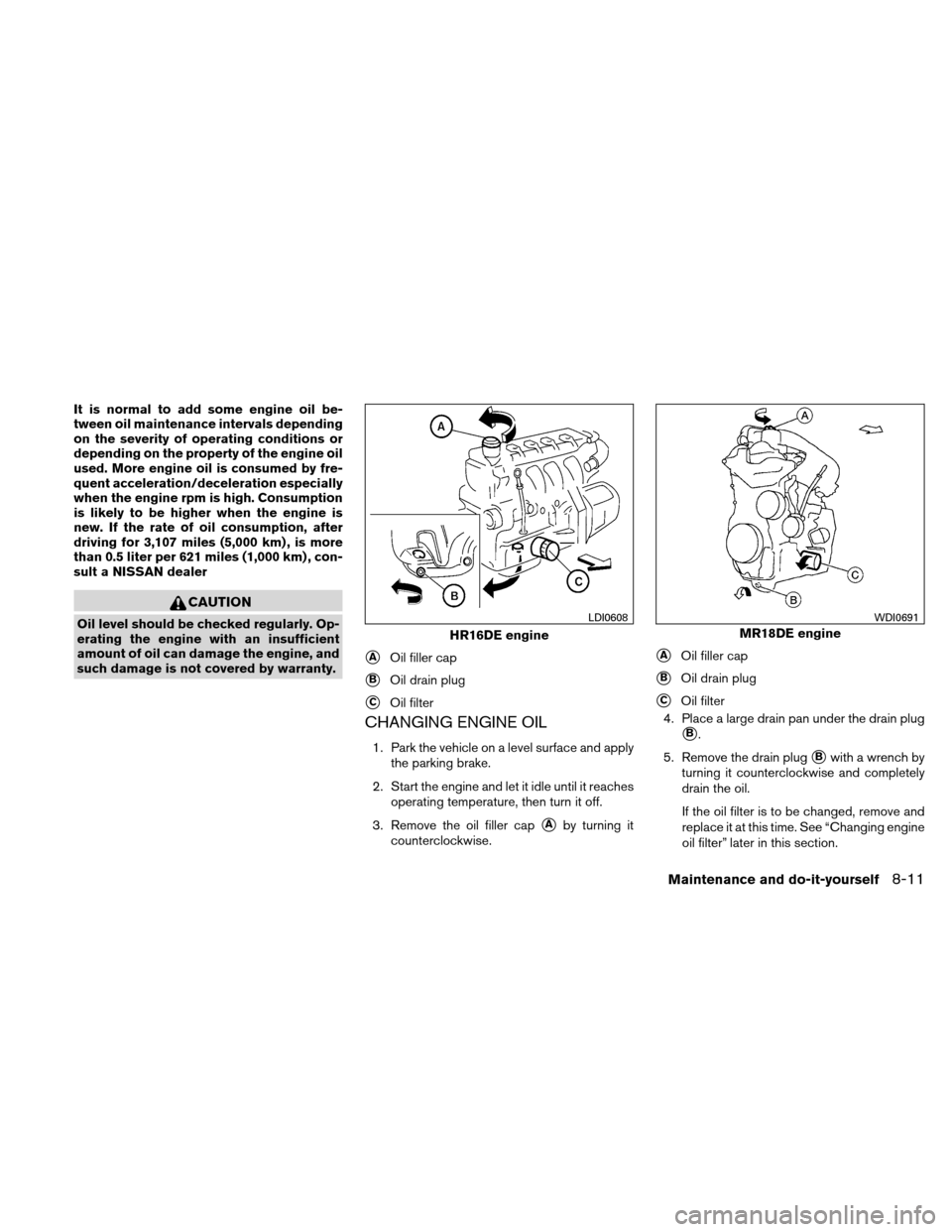
It is normal to add some engine oil be-
tween oil maintenance intervals depending
on the severity of operating conditions or
depending on the property of the engine oil
used. More engine oil is consumed by fre-
quent acceleration/deceleration especially
when the engine rpm is high. Consumption
is likely to be higher when the engine is
new. If the rate of oil consumption, after
driving for 3,107 miles (5,000 km) , is more
than 0.5 liter per 621 miles (1,000 km) , con-
sult a NISSAN dealer
CAUTION
Oil level should be checked regularly. Op-
erating the engine with an insufficient
amount of oil can damage the engine, and
such damage is not covered by warranty.
CHANGING ENGINE OIL
1. Park the vehicle on a level surface and applythe parking brake.
2. Start the engine and let it idle until it reaches operating temperature, then turn it off.
3. Remove the oil filler cap
�Aby turning it
counterclockwise. 4. Place a large drain pan under the drain plug
�B.
5. Remove the drain plug
�Bwith a wrench by
turning it counterclockwise and completely
drain the oil.
If the oil filter is to be changed, remove and
replace it at this time. See “Changing engine
oil filter” later in this section.
HR16DE engine
�AOil filler cap
�BOil drain plug
�COil filter
LDI0608
MR18DE engine
�AOil filler cap
�BOil drain plug
�COil filter
WDI0691
Maintenance and do-it-yourself8-11
Page 285 of 350
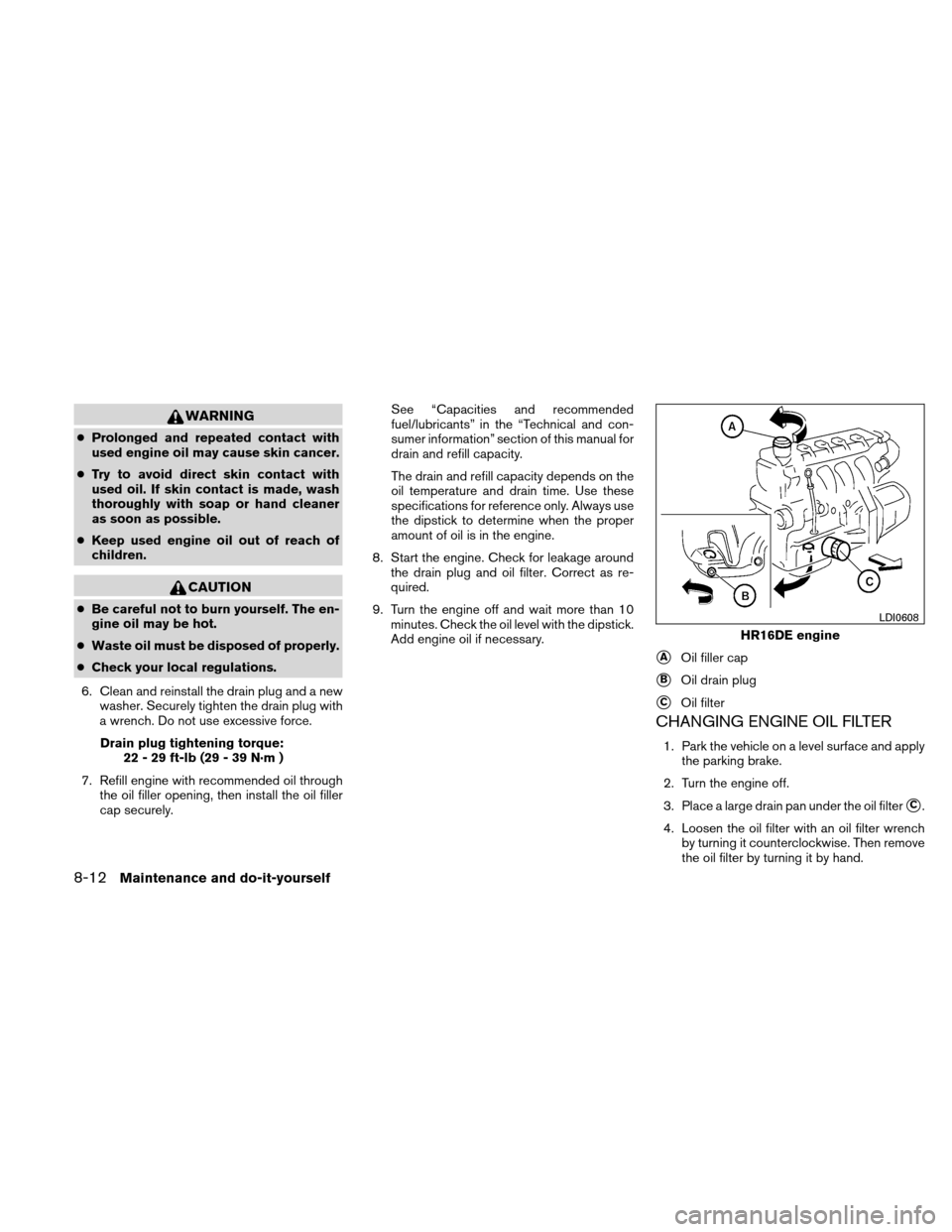
WARNING
●Prolonged and repeated contact with
used engine oil may cause skin cancer.
● Try to avoid direct skin contact with
used oil. If skin contact is made, wash
thoroughly with soap or hand cleaner
as soon as possible.
● Keep used engine oil out of reach of
children.
CAUTION
●Be careful not to burn yourself. The en-
gine oil may be hot.
● Waste oil must be disposed of properly.
● Check your local regulations.
6. Clean and reinstall the drain plug and a new washer. Securely tighten the drain plug with
a wrench. Do not use excessive force.
Drain plug tightening torque: 22 - 29 ft-lb (29 - 39 N·m )
7. Refill engine with recommended oil through the oil filler opening, then install the oil filler
cap securely. See “Capacities and recommended
fuel/lubricants” in the “Technical and con-
sumer information” section of this manual for
drain and refill capacity.
The drain and refill capacity depends on the
oil temperature and drain time. Use these
specifications for reference only. Always use
the dipstick to determine when the proper
amount of oil is in the engine.
8. Start the engine. Check for leakage around the drain plug and oil filter. Correct as re-
quired.
9. Turn the engine off and wait more than 10 minutes. Check the oil level with the dipstick.
Add engine oil if necessary.
CHANGING ENGINE OIL FILTER
1. Park the vehicle on a level surface and applythe parking brake.
2. Turn the engine off.
3. Place a large drain pan under the oil filter
�C.
4. Loosen the oil filter with an oil filter wrench by turning it counterclockwise. Then remove
the oil filter by turning it by hand.
HR16DE engine
�AOil filler cap
�BOil drain plug
�COil filter
LDI0608
8-12Maintenance and do-it-yourself
Page 286 of 350
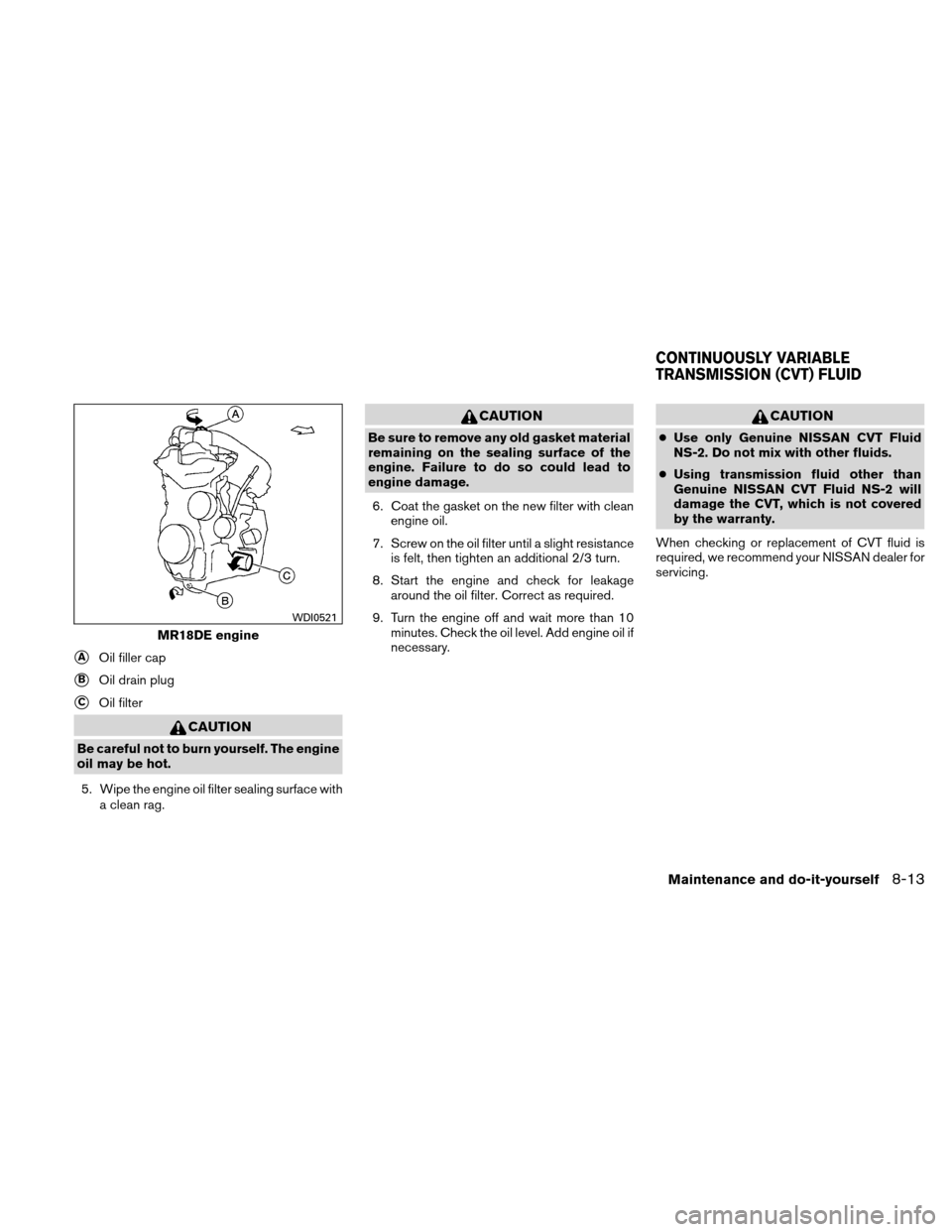
CAUTION
Be careful not to burn yourself. The engine
oil may be hot.5. Wipe the engine oil filter sealing surface with a clean rag.
CAUTION
Be sure to remove any old gasket material
remaining on the sealing surface of the
engine. Failure to do so could lead to
engine damage.
6. Coat the gasket on the new filter with clean engine oil.
7. Screw on the oil filter until a slight resistance is felt, then tighten an additional 2/3 turn.
8. Start the engine and check for leakage around the oil filter. Correct as required.
9. Turn the engine off and wait more than 10 minutes. Check the oil level. Add engine oil if
necessary.
CAUTION
●Use only Genuine NISSAN CVT Fluid
NS-2. Do not mix with other fluids.
● Using transmission fluid other than
Genuine NISSAN CVT Fluid NS-2 will
damage the CVT, which is not covered
by the warranty.
When checking or replacement of CVT fluid is
required, we recommend your NISSAN dealer for
servicing.
MR18DE engine
�AOil filler cap
�BOil drain plug
�COil filter
WDI0521
CONTINUOUSLY VARIABLE
TRANSMISSION (CVT) FLUID
Maintenance and do-it-yourself8-13
Page 287 of 350
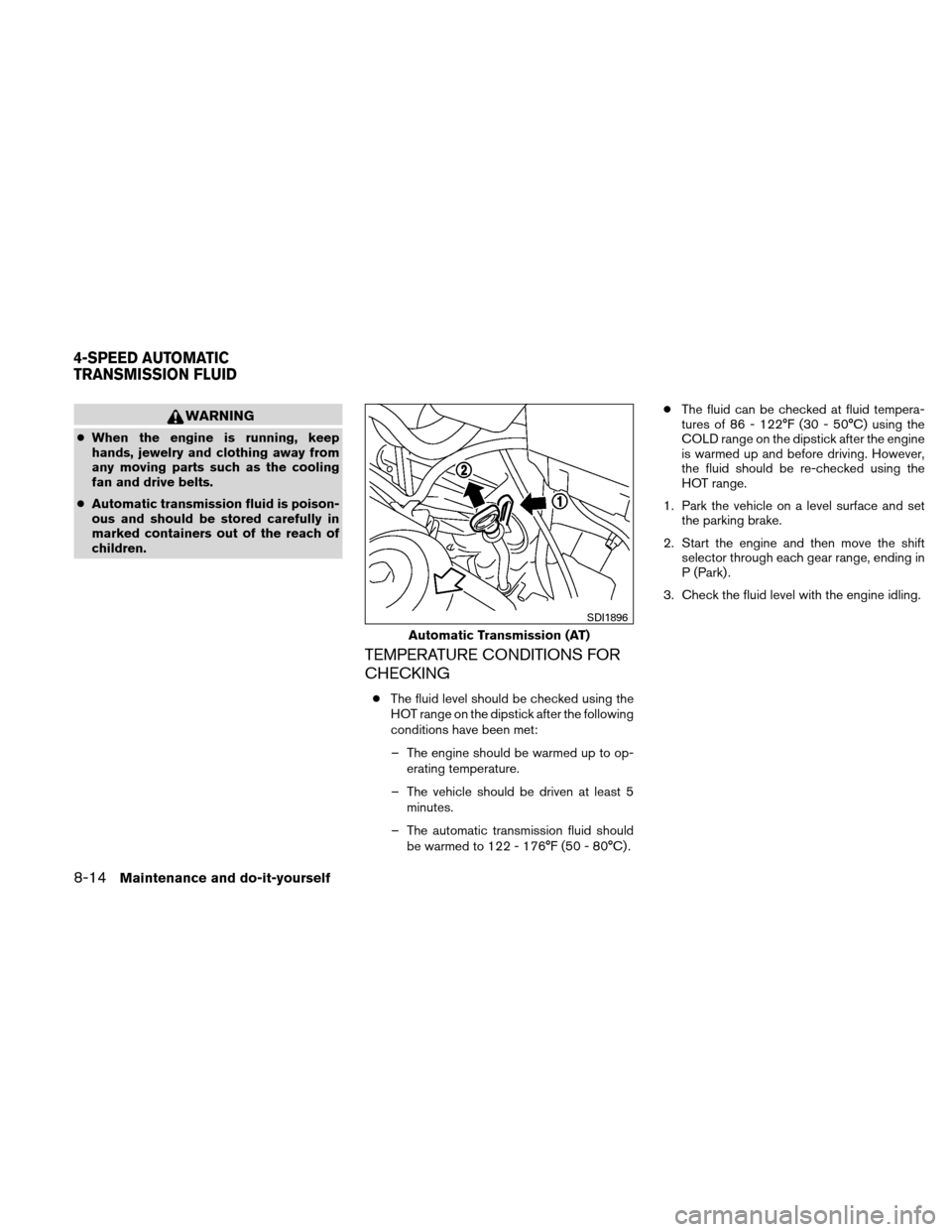
WARNING
●When the engine is running, keep
hands, jewelry and clothing away from
any moving parts such as the cooling
fan and drive belts.
● Automatic transmission fluid is poison-
ous and should be stored carefully in
marked containers out of the reach of
children.
TEMPERATURE CONDITIONS FOR
CHECKING
● The fluid level should be checked using the
HOT range on the dipstick after the following
conditions have been met:
– The engine should be warmed up to op- erating temperature.
– The vehicle should be driven at least 5 minutes.
– The automatic transmission fluid should be warmed to 122 - 176°F (50 - 80°C) . ●
The fluid can be checked at fluid tempera-
tures of 86 - 122°F (30 - 50°C) using the
COLD range on the dipstick after the engine
is warmed up and before driving. However,
the fluid should be re-checked using the
HOT range.
1. Park the vehicle on a level surface and set the parking brake.
2. Start the engine and then move the shift selector through each gear range, ending in
P (Park) .
3. Check the fluid level with the engine idling.
Automatic Transmission (AT)
SDI1896
4-SPEED AUTOMATIC
TRANSMISSION FLUID
8-14Maintenance and do-it-yourself
Page 290 of 350
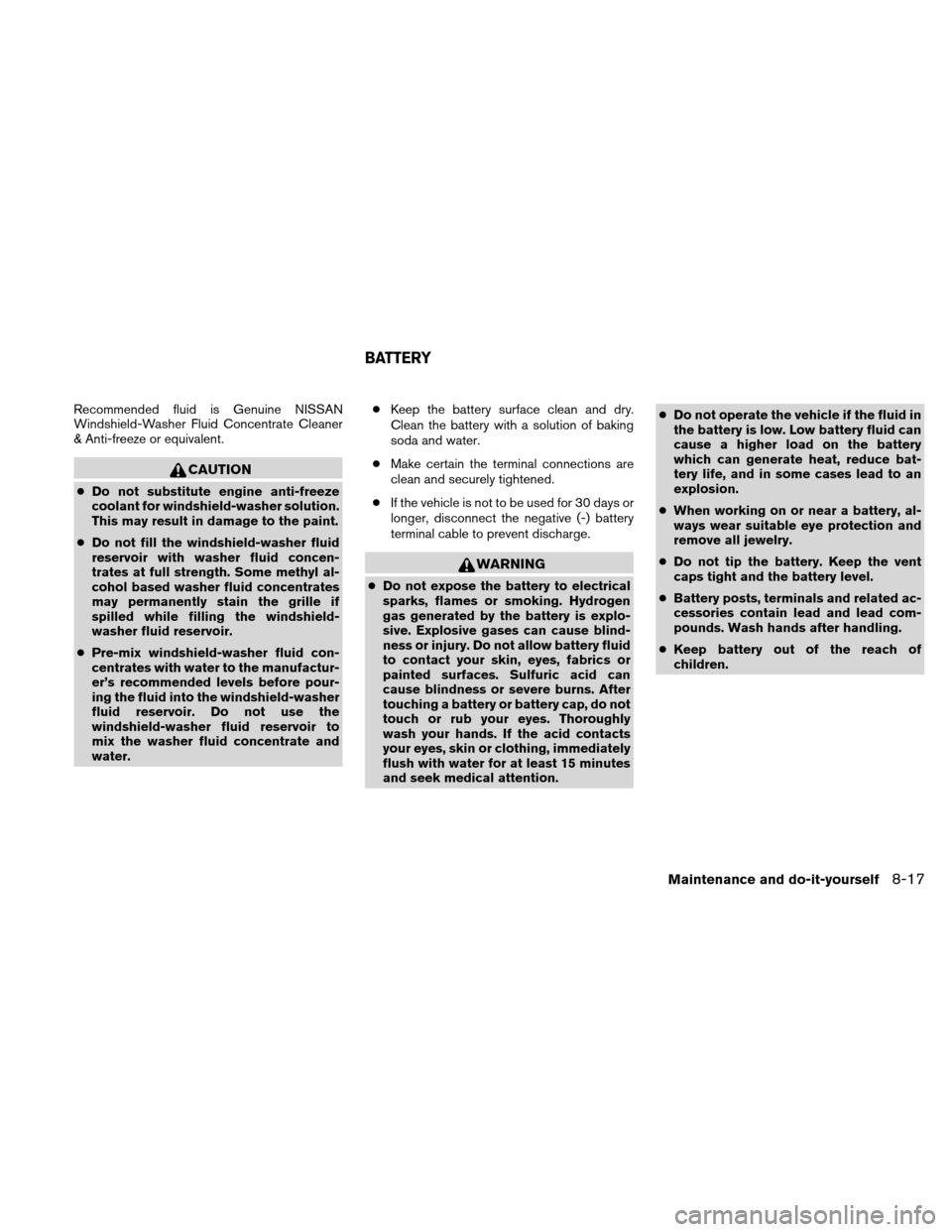
Recommended fluid is Genuine NISSAN
Windshield-Washer Fluid Concentrate Cleaner
& Anti-freeze or equivalent.
CAUTION
●Do not substitute engine anti-freeze
coolant for windshield-washer solution.
This may result in damage to the paint.
● Do not fill the windshield-washer fluid
reservoir with washer fluid concen-
trates at full strength. Some methyl al-
cohol based washer fluid concentrates
may permanently stain the grille if
spilled while filling the windshield-
washer fluid reservoir.
● Pre-mix windshield-washer fluid con-
centrates with water to the manufactur-
er’s recommended levels before pour-
ing the fluid into the windshield-washer
fluid reservoir. Do not use the
windshield-washer fluid reservoir to
mix the washer fluid concentrate and
water. ●
Keep the battery surface clean and dry.
Clean the battery with a solution of baking
soda and water.
● Make certain the terminal connections are
clean and securely tightened.
● If the vehicle is not to be used for 30 days or
longer, disconnect the negative (-) battery
terminal cable to prevent discharge.
WARNING
●Do not expose the battery to electrical
sparks, flames or smoking. Hydrogen
gas generated by the battery is explo-
sive. Explosive gases can cause blind-
ness or injury. Do not allow battery fluid
to contact your skin, eyes, fabrics or
painted surfaces. Sulfuric acid can
cause blindness or severe burns. After
touching a battery or battery cap, do not
touch or rub your eyes. Thoroughly
wash your hands. If the acid contacts
your eyes, skin or clothing, immediately
flush with water for at least 15 minutes
and seek medical attention. ●
Do not operate the vehicle if the fluid in
the battery is low. Low battery fluid can
cause a higher load on the battery
which can generate heat, reduce bat-
tery life, and in some cases lead to an
explosion.
● When working on or near a battery, al-
ways wear suitable eye protection and
remove all jewelry.
● Do not tip the battery. Keep the vent
caps tight and the battery level.
● Battery posts, terminals and related ac-
cessories contain lead and lead com-
pounds. Wash hands after handling.
● Keep battery out of the reach of
children.
BATTERY
Maintenance and do-it-yourself8-17
Page 291 of 350
1. Remove the battery vent caps with a screw-driver as shown.
2. Check the fluid level in each cell. If it isnecessary to add fluid , add only distilled
water to bring the level up to the bottom of
the filler opening. Do not overfill.
3. Reinstall the battery vent caps. Vehicles operated in high temperatures or under
severe conditions require frequent checks of the
battery fluid level.
JUMP STARTING
If jump starting is necessary, see “Jump starting”
in the “In case of emergency” section of this
manual. If the engine does not start by jump
starting, the battery may have to be replaced.
Contact a NISSAN dealer.
WDI0701
WDI0529
8-18Maintenance and do-it-yourself
Page 292 of 350
1. Water pump
2. Generator
3. Crankshaft pulley
4. Air conditioner compressor (if soequipped)
5. Manual tensioner
� Tension checking point 1. Automatic tensioner
2. Generator
3. Water pump
4. Air conditioner compressor (if so
equipped)
5. Crankshaft pulley
WARNING
Be sure the ignition switch is placed in the
OFF or LOCK position before servicing
drive belt. The engine could rotate
unexpectedly. 1. Visually inspect the belt for signs of unusual
wear, cuts, or fraying. If the belt is in poor
condition, have it replaced or adjusted by a
NISSAN dealer.
2. Have the belt checked regularly for condi- tion.
HR16DE engine
WDI0695
MR18DE engine
WDI0638
DRIVE BELT
Maintenance and do-it-yourself8-19
Page 293 of 350
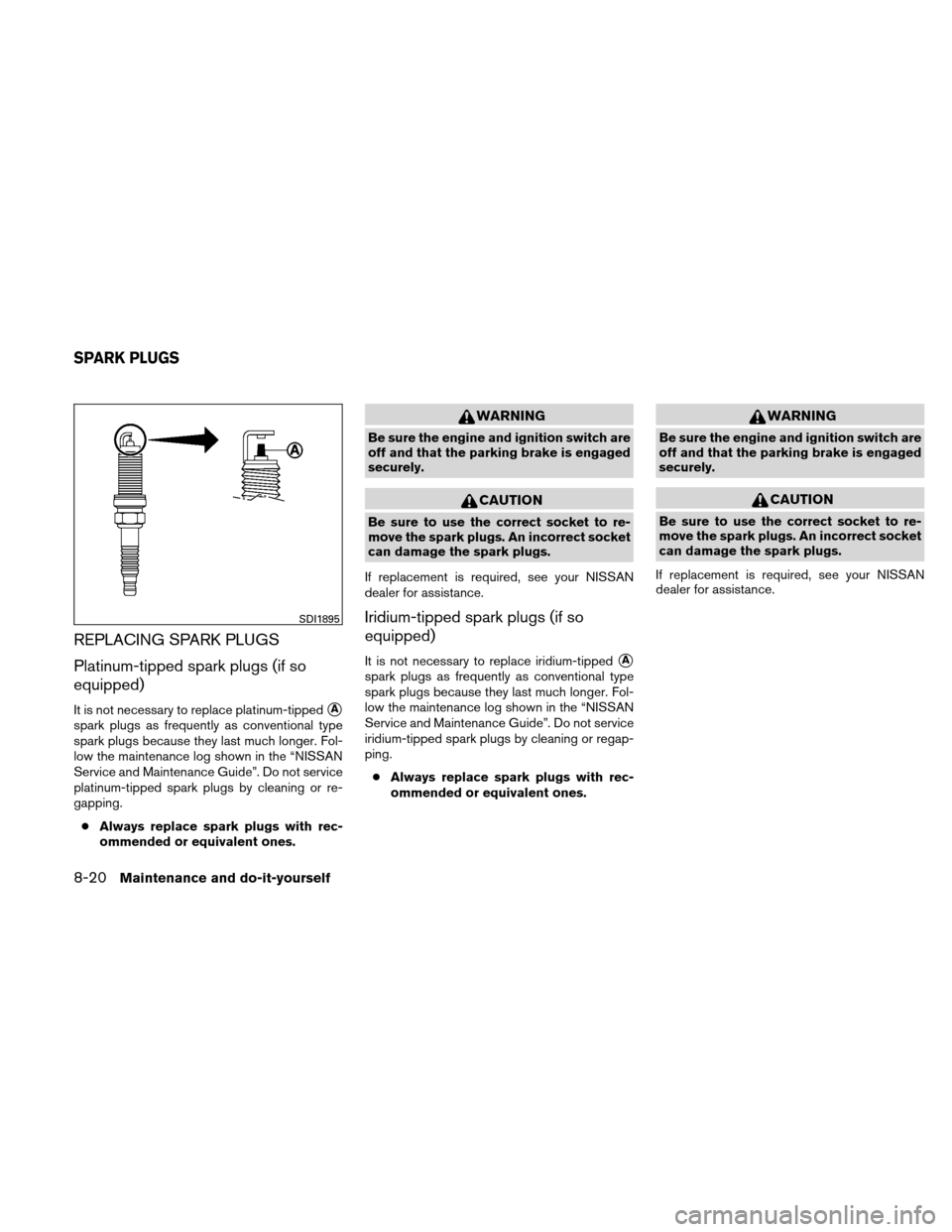
REPLACING SPARK PLUGS
Platinum-tipped spark plugs (if so
equipped)
It is not necessary to replace platinum-tipped�A
spark plugs as frequently as conventional type
spark plugs because they last much longer. Fol-
low the maintenance log shown in the “NISSAN
Service and Maintenance Guide”. Do not service
platinum-tipped spark plugs by cleaning or re-
gapping.● Always replace spark plugs with rec-
ommended or equivalent ones.
WARNING
Be sure the engine and ignition switch are
off and that the parking brake is engaged
securely.
CAUTION
Be sure to use the correct socket to re-
move the spark plugs. An incorrect socket
can damage the spark plugs.
If replacement is required, see your NISSAN
dealer for assistance.
Iridium-tipped spark plugs (if so
equipped)
It is not necessary to replace iridium-tipped�A
spark plugs as frequently as conventional type
spark plugs because they last much longer. Fol-
low the maintenance log shown in the “NISSAN
Service and Maintenance Guide”. Do not service
iridium-tipped spark plugs by cleaning or regap-
ping. ● Always replace spark plugs with rec-
ommended or equivalent ones.
WARNING
Be sure the engine and ignition switch are
off and that the parking brake is engaged
securely.
CAUTION
Be sure to use the correct socket to re-
move the spark plugs. An incorrect socket
can damage the spark plugs.
If replacement is required, see your NISSAN
dealer for assistance.
SDI1895
SPARK PLUGS
8-20Maintenance and do-it-yourself